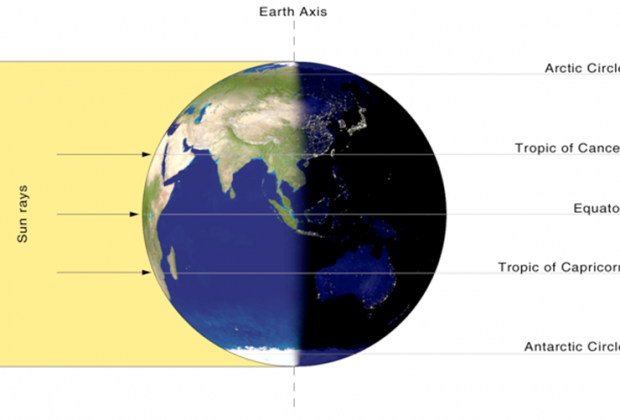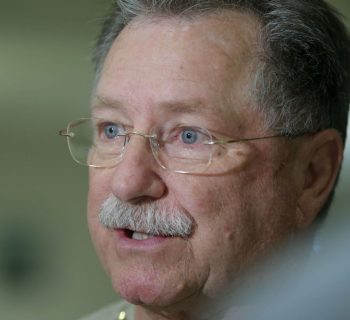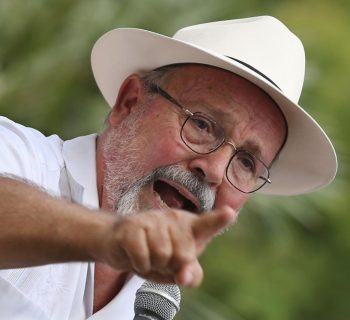By: Gonzalo Santos, Sociology Professor at CSU Bakersfield ~ March 20, 2017
Spring officially began worldwide this Monday, March 20, at precisely 10:28 UTC (Temps Universel Coordonné, or Coordinated Universal Time), marking the sun's precise halfway point of its six-month journey northward. For us in Bakersfield, Spring arrives Monday at 3:28 AM U.S. Pacific Time, allowing for daylight saving time.
The word equinox derives from the Latin words aequus (equal) and nox (night).
The crossing of the sun directly over the equator at this time of year is known as the vernal equinox in the Northern Hemisphere. The sun will continue its northern move until the June solstice on June 21, when the northern hemisphere will experience the longest day of the year -- for us in Bakersfield, it'll be 14 hours, 32 minutes 45 seconds between sunrise and sunset -- and in the southern hemisphere, the shortest. From then on and for the next six months, the sun will move southward, completing the yearly cycle on the December solstice (this year on the 21st.), when we'll have the shortest day of the year -- in Bakersfield lasting only 9 hours, 46 minutes and 15 seconds between sunrise and sunset.
 Because the Earth's axis of daily rotation is tilted with respect to the plane of its yearly orbit around the sun, this is one of only two times of
Because the Earth's axis of daily rotation is tilted with respect to the plane of its yearly orbit around the sun, this is one of only two times of  the year when days and nights are as equal in duration as possible in any given 24-hour period (the other equinox is the first day of fall in the Northern Hemisphere and spring in the Southern, which this year falls on Sept. 22 at 20:02 UTC, or 1:02 PM here in Bakersfield).
the year when days and nights are as equal in duration as possible in any given 24-hour period (the other equinox is the first day of fall in the Northern Hemisphere and spring in the Southern, which this year falls on Sept. 22 at 20:02 UTC, or 1:02 PM here in Bakersfield).
This is also one of the two times of year when the sun rises directly in the east and sets directly in the west. Many ancient horticultural societies - like those of Chaco Canyon in the U.S. Southwest, or throughout Mesoamerica, for example, aligned their sacred buildings, main roads, and even towns relative to each other, to correspond to this day.
To the left and right are rock formations in Chaco Canyon where the Anasazi ingeniously tracked all equinoxes and solstices, as well as the long (18.6-year) lunar cycles, using "sun daggers" and spiral petroglyphs.
By far the most famous such case is found in Chichen Itza's famed Temple of Kukulkan (the Maya name for the plumed serpent god Quetzalcoatl), in Yucatán, México, declared in 2007 - after a worldwide web-based public referendum - one of the New Seven Wonders of the World (the other one in the Western Hemisphere is Machu Picchu in Peru).
Every March and September equinoxes, at the rising and setting of the sun, the corner of the structure casts a shadow in the shape of a plumed serpent - Kukulkan, or Quetzalcoatl - along the east & west sides of the north staircase. respectively.
On these two days, the shadows from the corner tiers slither down the northern side of the pyramid with the sun's movement to the serpent's head at the base. Thousands from all over the world come to see this amazing feat of architecture & astronomy. [Below: Dzibilchaltun, Yucatan]

The March equinox marks the first day of various calendars including the Iranian calendar and the Bahá'í calendar. The Persian (Iranian) new year's festival of Nowruz is celebrated then. According to the ancient Persian mythology Jamshid, the mythological king of Persia, ascended to the throne on this day and each year this is commemorated with festivities for two weeks. These festivities recall the story of creation and the ancient cosmology of Iranian and Persian people.
 [<--Bas-relief in Persepolis (the ceremonial capital of the Persian Empire during the Achaemenid dynasty ca. 550-330 BCE), showing a symbol of the Iranian & Persian Nowruz on the equinox, when the power of an eternally fighting bull (personifying the Earth) and that of a lion (personifying the Sun) are equal.]
[<--Bas-relief in Persepolis (the ceremonial capital of the Persian Empire during the Achaemenid dynasty ca. 550-330 BCE), showing a symbol of the Iranian & Persian Nowruz on the equinox, when the power of an eternally fighting bull (personifying the Earth) and that of a lion (personifying the Sun) are equal.]
Monday, the sun will rise at 6:59 a.m. and will set at 7:08 p.m. here in Bakersfield. If you are scientifically inclined, go out at those times to your closest true east-west street - or use your camping or car compass - just to be sure the street or your compass is aligned with the sun! Another fun activity you can do with your kids: at either sunrise or sunset, mark the place where any fixed object in your home, such as something on a window, makes a clear sharp shadow on a wall bathed in sunlight; then, as the seasons pass, follow it the rest of the year, as that same shadow moves one way, then after the Dec. 21 solstice, back across the mark until it reaches the other extreme on the June 21 solstice next year.
 And finally, for those imbued with a spiritual reverence of the ancients towards cosmic harmonies, burn a little incense in your backyard, on your roof, or in your bedroom tonight, in honor of Mother Earth's bi-annual moment of perfect equilibrium (right) in her eternal, graceful, cyclical, life-giving pirouette around the Sun Ra (left).
And finally, for those imbued with a spiritual reverence of the ancients towards cosmic harmonies, burn a little incense in your backyard, on your roof, or in your bedroom tonight, in honor of Mother Earth's bi-annual moment of perfect equilibrium (right) in her eternal, graceful, cyclical, life-giving pirouette around the Sun Ra (left).
Quite a celestial dance!







